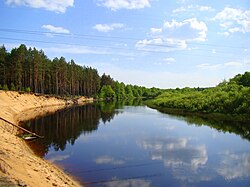Berezina
Appearance
This article needs additional citations for verification. (October 2013) |
| Berezina River | |
|---|---|
 Berezina River in Belarus | |
 | |
| Native name | Template:Lang-be Error {{native name checker}}: parameter value is malformed (help) |
| Location | |
| Country | Belarus |
| Physical characteristics | |
| Source | |
| • location | Belarus |
| Mouth | Dnieper |
• coordinates | 52°32′59″N 30°15′00″E / 52.54972°N 30.25000°E |
| Length | 561 km (349 mi)[1] |
| Basin size | 24,500 km2 (9,500 sq mi)[1] |
| Basin features | |
| Progression | Dnieper→ Dnieper–Bug estuary→ Black Sea |
The Berezina or Biarezina[2] (Template:Lang-be; pronounced [bʲaˈrɛzʲinɐ]) is a river in Belarus and a right tributary of the Dnieper. Its main tributaries are Bobr, Klyava, Ol'sa and Ala from the left and Hayna and Svislach from the right.[3]
The Berezina Preserve by the river is on the UNESCO list of Biosphere Preserves.
Cities and towns on the Berezina
Historical significance
- Napoleon Bonaparte's army suffered heavy losses (about 36,000) when crossing the Berezina in November 1812 during his retreat from Russia (see Battle of Berezina). Since then "Berezina" is used in French as a synonym for catastrophe.
- Charles XII of Sweden's army crossed the Berezina on June 25, 1708 during his campaign against Peter the Great of Russia in the Great Northern War. (see ISBN 0-306-80863-3 for details)
- Several armies in German Wehrmacht Army Group Centre were entrapped and prevented from crossing the Berezina in June 1944, during the envelopment phases of the Bobruysk and Minsk Offensives, within the closing phases of Operation Bagration in World War II.
- There were military actions between Germany and Russia at the Berezina River in 1917–1918.[citation needed]
- Several battles are named after the river.
See also
- Charles Joseph Minard § The map of Napoleon's Russian campaign for a visual graphic of the army's fate
References
- ^ a b "Main Geographic Characteristics of the Republic of Belarus. Main characteristics of the largest rivers of Belarus". Land of Ancestors. Data of the Ministry of Natural Resources and Environmental Protection of the Republic of Belarus. 2011. Archived from the original on 15 January 2014. Retrieved 27 September 2013.
- ^ official transliteration
- ^ Березина, Great Soviet Encyclopedia
Wikimedia Commons has media related to Berezina.

